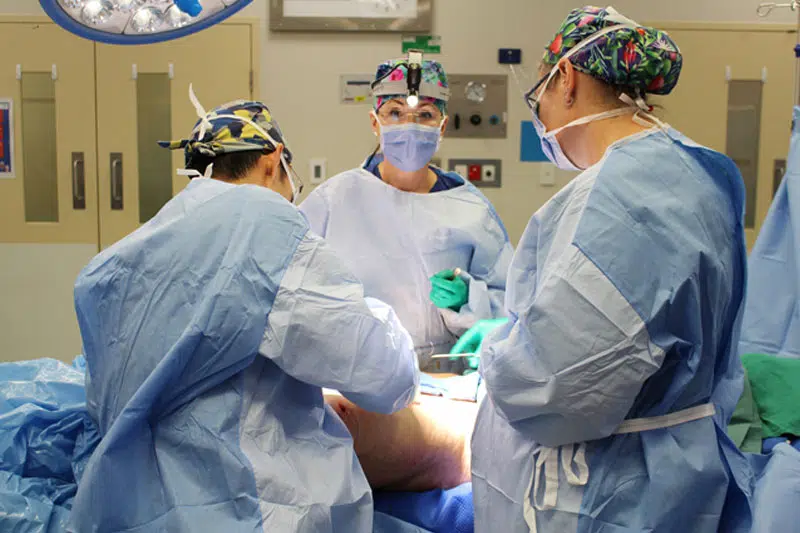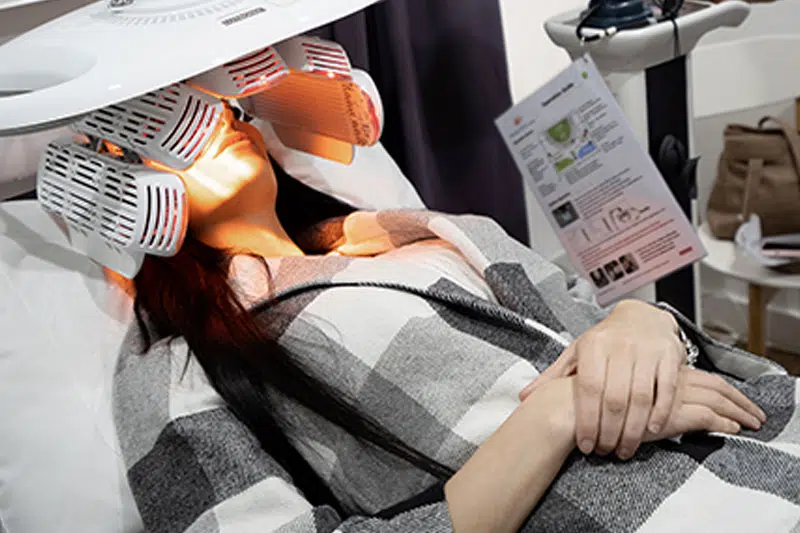Targeting Submental Fullness
Submental Fullness refers to the accumulation of fat under the chin, which can be referred to as a double chin. There are several factors that can contribute to the development of submental fullness, including; weight fluctuation, ageing, genetics and lifestyle habits. While exercise and diet may help manage weight, it often has a limited impact on submental fullness, especially if it is a result of genetics or ageing. In situations like this, Chin Liposuction or non surgical treatments may help address submental fullness.
Specialist Plastic Surgeon Dr Gary Kode, provides customised Chin Liposuction procedures, carefully planned to suit each person’s facial structure and aesthetic preferences.
What Is Chin Liposuction?
Chin Liposuction, also known as Submental Liposuction, is a cosmetic surgical procedure that focuses on reducing excess fat beneath the chin and around the upper neck area. This procedure aims to increase the definition of the jawline and alter the lower face profile by removing fat deposits using a fine cannula and suction technique.
Chin Liposuction is typically performed as a standalone procedure or alongside other facial surgeries, such as a Facelift or Neck Lift, to provide more comprehensive results.
Am I a Suitable Candidate for Chin Liposuction?
Chin Liposuction may be an option for individuals looking to address excess fat beneath the chin and increase chin and jawline definition. You may be a suitable candidate for this procedure if you:
- Are concerned that your jawline lacks definition or structure.
- Experience persistent fullness under the chin that does not respond to lifestyle changes.
- Are in good overall health
- Do not smoke, or are willing to stop smoking prior to surgery and throughout the recovery period.
- Have good skin elasticity, which supports optimal healing and results.
- Maintain a stable and suitable body weight.
- Have realistic expectations about the outcomes of the procedure
A personal consultation with a qualified specialist plastic surgeon like Dr Gary Kode can help determine whether Chin Liposuction is a suitable option for your individual needs and anatomy.
Potential Benefits of Chin Liposuction
Chin Liposuction offers a range of potential benefits. While individual outcomes may vary, the procedure may help to:
- Reduce submental fullness: By targeting excess fat under the chin, the procedure can result in a more defined neck and chin profile.
- Increased jawline definition: Altering the appearance can lead to a sharper, more structured appearance of the lower face.
- Increased overall facial balance: A more proportionate chin and jawline can contribute to increased harmony between facial features.
- Address stubborn fat deposits: May be particularly helpful for patients whose submental fat does not respond to traditional weight loss methods.
While Chin Liposuction can effectively target fat, it is not designed to address skin laxity or underlying muscle banding (such as platysmal bands). In cases where loose skin or muscle separation is present, additional procedures (like a Neck Lift/Platysmaplasty) may be considered.
What Does the Chin Liposuction Procedure Involve?
Chin Liposuction is typically performed under local anaesthesia with sedation or, in some cases, general anaesthesia. The type of anaesthesia will depend on individual circumstances and the complexity of the procedure.
A small incision is usually made beneath the chin or behind the ears, through which a fine cannula is inserted and excess fat is removed. This process aims to reduce stubborn fat deposits in the submental area (under the chin), contributing to a more defined appearance of the jawline and neck.
The procedure generally takes between 30 minutes to one hour and is often performed as a day surgery. However, the exact duration and recovery plan may vary depending on whether Chin Liposuction is performed alone or alongside other procedures.
Recovery After Chin Liposuction
Recovery following Chin Liposuction varies between individuals, but most patients can expect a manageable and progressive healing process. Mild to moderate swelling, bruising, and a sensation of tightness in the treated area are to be expected and are generally temporary.
To support recovery and optimise outcomes, a specially fitted compression garment is typically worn around the chin and neck. This garment helps reduce swelling, assist with skin retraction, and support healing tissues.
Following Dr Kode’s post-operative care instructions is essential for not only your recovery but also in reducing the risk of complications.
Week 1: Initial Recovery
During the first few days, discomfort and tightness are usually at their peak. This can often be managed with over-the-counter pain relief or medication prescribed by Dr Kode. Applying cold compresses as directed may help to ease swelling and discomfort. Patients are also advised to keep their head elevated and limit excessive movement of the neck and jaw.
By the end of week one, many patients feel well enough to return to work and resume light social activities. While swelling and bruising may still be present, they usually begin to subside. It’s important to continue wearing the compression garment as recommended.
Weeks 2–4: Ongoing Healing
Swelling and bruising typically continue to decrease during this time. Most daily activities can be resumed, with the exception of vigorous exercise or strenuous movement. Patients should only return to high-impact physical activity once cleared by Dr Gary Kode or his team.
Week 6 and Beyond: Final Results
By approximately six weeks post-procedure, the majority of residual swelling has settled and the altered shape of the chin and jawline becomes more visible. Although slight changes can continue over the following weeks or months, most patients see their results by this stage.
Supporting your Recovery
Dr Gary Kode’s team is committed to patient care throughout every stage of your surgical journey. Before your procedure, you’ll receive a comprehensive post-operative plan tailored to your needs, including tips for caring for the incision sites, managing discomfort, and optimising results.
In addition to regular follow-up appointments, the team is available to answer any concerns or questions during your recovery period. Every individual heals at their own pace, and your post-operative care will be closely monitored to make sure your healing progresses as expected.
Chin Liposuction Before and After Photos
The before and after images below are for educational purposes only. The results shown are only relevant to the patient and do not reflect or promise that other patients will be able to achieve these results. They are a tool to help visualise what changes may be possible with Chin Liposuction performed by Dr Kode. The images below are patients of Dr Kodes who have given written permission to have their photos used.
***PHOTOS COMING SOON***
Disclaimer: Individual results will vary depending on several factors including; age, skin health, body type, medical history and lifestyle. All surgical procedures carry risks and it’s important to understand these before undergoing surgery. Photographs are not intended to guarantee results.
Potential Risks and Considerations
All surgical procedures carry risks. With Chin Liposuction, these may include:
- Swelling, bruising, and temporary numbness
- Irregular contours or asymmetry
- Infection or bleeding
- Scarring
- Unsatisfactory aesthetic result
Dr Kode will thoroughly explain the potential risks and help you decide whether the procedure aligns with your needs and expectations. For more information visit our Risks and Complications of Plastic Surgery Page.
Chin Liposuction vs. Non-Surgical Options
While there are non-surgical treatments available for submental fullness, such as fat-dissolving treatments or energy-based skin tightening devices, these may not be suitable for everyone and typically require multiple sessions.
Non-surgical options aim to gradually reduce fat and stimulate collagen production in the treated area. These treatments can offer slight changes over time, but it’s important to understand that:
- They typically require multiple sessions spaced several weeks apart.
- Results are often more gradual and less comprehensive than Liposuction.
- Not all patients are suitable candidates, especially those with significant skin laxity or a larger volume of excess fat.
- In some cases, non-surgical treatments may not produce the desired results and patients may still opt for surgical intervention later.
Ultimately, choosing between surgical and non-surgical options depends on your aesthetic goals, the amount of fat and skin laxity present and your personal preferences around downtime and results. During your consultation, Dr Kode will assess your suitability for each treatment and discuss your options.
Cost of Chin Liposuction in Melbourne
The cost of Chin Liposuction can vary depending on the complexity of the procedure, anaesthetic requirements, hospital or facility fees, and whether additional procedures are performed at the same time.
A personalised quote will be provided after a consultation with Dr Kode.
Note: Chin liposuction is typically considered a cosmetic procedure and is not covered by Medicare or private health insurance.
Choosing a Qualified Chin Liposuction Surgeon in Melbourne
When considering any form of cosmetic surgery, it’s important to choose a qualified Specialist Plastic Surgeon with recognised training and hospital operating rights.
Dr Gary Kode is a Specialist Plastic Surgeon with extensive experience in facial aesthetic surgery. He performs Chin Liposuction with a patient-focused approach, prioritising care and safety at every stage.
Book a Consultation
If you are considering Chin Liposuction in Melbourne, a consultation with Dr Gary Kode is the first step. During your appointment, Dr Kode will assess your concerns, discuss your treatment options, and provide a tailored surgical plan.
Disclaimer: The information provided is for educational purposes only and does not constitute medical advice. Individual results may vary and all surgery carries risks and potential complications. A thorough consultation is necessary to determine the most appropriate treatment plan for your specific circumstances





